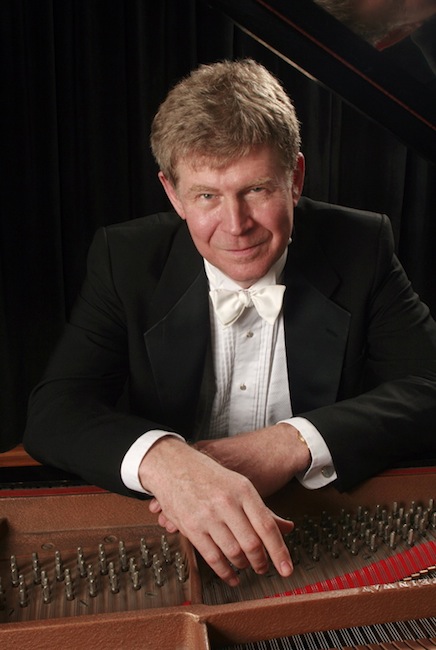Hobson’s deep, robust playing animates music across the centuries
Through the current concert season, pianist Ian Hobson has been playing his way through masterpieces of the piano repertoire, as well as new compositions, in a series he calls “Preludes, Etudes, and Variations-Downtown/Uptown.”
The title is a mouthful, but informative: Hobson is playing familiar and new works in each of the three forms, in concerts at SubCulture (downtown) and Merkin Concert Hall (uptown). Tuesday night, Hobson was uptown, playing the Op. 28 Preludes from Chopin, new Etudes by Robert Chumbley, and Variations by Rachmaninoff.
Hobson’s series, as described in a short pre-concert speech by Paul Griffiths, is a dialogue with history. That would seem to be the standard and unremarkable goal of every classical music concert, but in practice classical music is still commonly treated as a precious diorama.
This is an inherently robust way to make music that was reinforced by Hobson’s powerful playing. He produced a big sound, not because his hands were heavy but because that was where his thinking led.
The Chopin Preludes are sufficiently popular on recordings and concert programs that one always hopes to hear some individual thinking in any performance. Hobson provided that: this was Freudian Chopin, not about pianism (though certainly played well) but about the layers and layers of agitation and intensity inside the music. Hobson played from deep inside those layers, working his way outward and pushing the edge of the anxious nervous energy that is buried within. He tended toward faster tempos and a limited and judicious rubato.
This was not the familiar poetic Chopin. Certain preludes, like No. 2 and the “Raindrop” Prelude, No. 15, were not just quick but weighty and dark, the transformation of the music from delicate to funereal full of tragedy. Even the stately Prelude No. 20 had a forward-leaning edge, exemplary of the pianist’s stimulating and satisfying approach. The Preludes already have a disjointed, unsettled structure, and Hobson emphasized how different each was, faces on a icosikaitetragon, rather than smoothly related segments of a linear narrative. Even cadences to the tonic left an appropriately unsettled feeling, as if each Prelude was a question left hanging in the air.
Hobson completed the first half with relatively lighter interpretations of the posthumous A-flat Prelude and the C-sharp minor, Op. 45 one.
The dialogue with history, via Chopin, took place after intermission, beginning with the world premiere of Chumbley’s Études, commissioned as part of Hobson’s project.
Chumbley’s piece is modeled after Chopin, but strays in subtle ways, as if honoring the master while quietly asserting its own path. While the sound of cascading, arpeggiated chords is familiar from Chopin, the formal design is more settled. These are etudes, not preludes, answers rather than questions.
Hobson powered through the music with even greater intensity, a quality that is clearly at the core of his musicianship, starting a new etude while a final cadence was still reverberating. This made the details of the formal structure hard to discern on the first listen, though that was less relevant than the dynamic feeling of the music.
Chumbley’s reaction to the technical demands of Chopin’s composing was to dig in deeper. Rushing sequences of parallel chords spiraled toward a crunchy harmonic and emotional complexity. The music sounded as if it found Chopin both compelling and maddening, a wonderful response to the Polish composer’s unique complexities.
The concert finished on a more serene note. Last on the bill was the sound of an older generation working through the legacy of Chopin. Rachmaninoff’s Op. 22 Variations on a Theme of Chopin begins with Prelude No. 20 from Chopin’s Op. 28, then moves along in a good-natured but self-possessed response.
Rachmaninoff, like Chopin, was a special pianist, with a rare range, agility, and touch. Chopin’s music is an example of the art a great pianist can produce, as was Rachmaninoff’s, and there’s something attractively cheeky about Op. 22, a see-you/raise-you response.
Equally, the music has a lyrical loveliness that pays homage to Chopin, an acknowledgment of a debt. Hobson played with a feeling of honesty—his intensity was a given, but his touch was lighter and more transparent, true to music that is fundamentally a show of both pianistic and compositional technique. One heard both Hobson’s fine playing and Rachmaninoff’s fine thinking.
There was a strong, appreciative ovation from the full crowd, which Hobson thanked with one more bit of historical conversation and charm, Rachmaninoff’s transcription of Fritz Kreisler’s “Liebesleid” waltz from Three Old Viennese Songs.
“Preludes, Etudes, and Variations-Downtown/Uptown” continues with music by Chopin, Rachmaninoff, and Debussy, 7:30 p.m. February 22 at Merkin Concert Hall. IanHobsonDowntownUptown.



